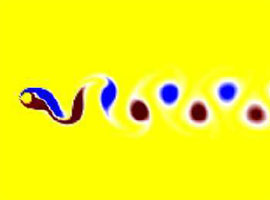| |
 Vortices commonly occur in many applied sciences, such as fluid dynamics, superconductivity, and atomic physics.
Vorticity spikes, called vortices, are observed in modeling of turbulence and flow control. Using vorticity
formulation and the vortex method, computational flow control can be effectively implemented.
Vortices commonly occur in many applied sciences, such as fluid dynamics, superconductivity, and atomic physics.
Vorticity spikes, called vortices, are observed in modeling of turbulence and flow control. Using vorticity
formulation and the vortex method, computational flow control can be effectively implemented.
In type-II superconductors under a strong external magnetic field, the flux lines do not permeate the entire
sample uniformly, but rather penetrate through narrow tubes called vortices. In the core region of each
vortex superconductivity is destroyed, and outside of the core region the magnetic field is very small.
The famous hexagonal Abrikosov vortex lattice was not originally predicted by Abrikosov himself (he thought
the lattice should be square) but was verified by numerical simulations. A mathematical proof of the hexagonal
form remains an open question.
Discrete vortices occur in modeling of Bose-Einstein condensates in periodic optical lattices. By using
Lyapunov-Shmidt reductions, the discrete vortices can be traced from their origin analytically and numerically,
and their dynamics can be modeled with discrete (finite-difference) nonlinear equations.
|
|